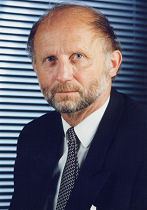Nationality German | Role Scientist Name Achim Muller | |
 | ||
Institutions University of Bielefeld Alma mater University of Gottingen Similar People C N R Rao, Leroy Cronin, Klaus Mainzer | ||
Education University of Gottingen | ||
Der perfekte backfisch mit chefkoch achim muller i foodle food recipe
Achim Müller (born 14 February 1938 in Detmold, Germany) is a German scientist. He is Professor Emeritus at the Faculty of Chemistry, University of Bielefeld.
Contents
- Der perfekte backfisch mit chefkoch achim muller i foodle food recipe
- Spagetti Bolognese von Jugend gekocht Wer gewinnt das Battle Abenteuer Leben kabel eins
- Academic career
- Research
- Personal
- References
Spagetti Bolognese von Jugend gekocht: Wer gewinnt das Battle? | Abenteuer Leben | kabel eins
Academic career

Achim Müller studied chemistry and physics at the University of Göttingen and received there his PhD degree (1965) and the Habilitation (1967). In 1971, he became professor at the University of Dortmund and in 1977 professor of Inorganic Chemistry at the University of Bielefeld. In 2006 he got the Manchot-Forschungsprofessur of the Technische Universität München. He received but subsequently declined an invitation to succeed Professor F. Seel at Saarbrücken in 1982. His research involves mainly the chemistry of transition metals, especially with relation to nanochemistry, furthermore bioinorganic chemistry including biological nitrogen fixation, molecular magnets (even one showing quantum oscillations), molecular physics (including theoretical studies of isotope-substitution changes on molecular constants and experimental investigations based on various sophisticated vibrational spectroscopic techniques, e.g. matrix isolation) as well as history and philosophy of science. He has published about 900 original papers in more than 100 different journals related to different fields, more than 40 reviews and is coeditor of 16 books (see External links below). Achim Müller is a member of several national, e.g. the Leopoldina and international academies, e.g. Polish Academy of Sciences, The Indian National Science Academy, National Academy of Exact Physical and Natural Sciences (Argentina), Academia Europaea and has received many awards (honorary doctor degrees, e.g. of the Russian Academy of Sciences (RAS) and the Université Pierre et Marie Curie, Paris; -professorships and -memberships; see External links) and prizes (e.g. Alfred Stock Memorial Prize 2000, Prix Gay-Lussac/Humboldt 2001, Sir Geoffrey Wilkinson Prize 2001, Centenary Medal of the Royal Society of Chemistry 2008/9, London), and several prominent lectureships. In 2012 he was awarded with the prestigious Advanced Grant by the European Research Council (ERC) (for more honors see External links). From Nature Chemistry he got an invitation to write an article about the future of Inorganic Chemistry for the first issue of the journal in 2009 ("Predicting a structured future").
Research
His currently most compelling research relates mainly to bottom-up pathways towards tailor-made porous metal oxide nanoclusters (like Mo132; model purchasable from a company: http://www.moleculart3d.com/) and their use as versatile materials of interdisciplinary character. This includes the following topics as well as applications (see especially Ref.):
Müller's discovery of the molecular giant spheres (Keplerates) of the type Mo132 (diameter ca. 3 nm) and their derivatives, of the wheel shaped cluster Mo154 (Refs. and ) and hedgehog shaped cluster Mo368 (as large as 6 nm) has caused a paradigm shift regarding their sizes and especially due to their unique properties as nanomaterials. These single molecules are quite large; this can be shown by taking the length of an oxygen molecule with two atoms (length 0.12 nm) as a unit, then considering Mo368 which is 50 times larger. Müller's related work shows many applications (see above), for example, how cellular processes like ion-transport can be modelled based on the spherical porous capsules and how the latter can be used to remove toxic compounds from water. All the mentioned nanomaterials belong to a class commonly termed polyoxometalates and some special ones to the molybdenum blue family; its long 200-year old mystery was solved by him. The compounds are studied worldwide by many groups especially related to problems of Materials Science (see Ref.). One aspect is modelling of the Lotus effect, another one chemical adaptability as a new phenomenon. An interesting mathematical treatment of the Keplerates could be developed in relation to spherical viruses and Buckminster Fuller Domes based on Archimedean and Platonic solids. The unique range of potential applications of the Mo132 Keplerates has also been highlighted by several other authors, e.g.: "Thus, Keplerate-type capsules represent unique supramolecular objects offering a tunable spatially-restricted environment and promising in many domains such as catalysis, electric conductivity, non-linear optics, liquid crystals, vesicles and "blackberry" aggregates. ...a key point to promote confined space engineering." In another publication it is written: "Initiated and led by Müller and co-workers, the synthesis and structural characterization of protein-sized metal oxide clusters (2-6 nm) have generated great interest in the areas of physics, biology, chemistry, and materials science"; see also Ref. Some of the clusters can be obtained by planned synthesis. The Keplerates can be arranged accurate to size, while the Mo72Fe30 has unique magnetic properties. There are two older synthetic topics where Achim Müller did pioneering work. This refers to basic simple transition metal sulphur compounds, including related hydrodesulfurization catalysis and a new type of host guest chemistry based on polyoxovanadates (for both topics see especially the two Honorary Issues under Bibliography). One paper about polyoxometalates was cited ca. 2000 times.
Personal
Müller likes ancient Greek philosophy, classical music, and mountain hiking. He has a love for woodland birds since his early childhood, a pastime which his father cherished also.
